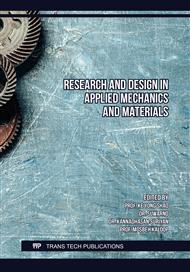p.3
p.11
p.21
p.29
p.37
p.45
p.55
p.77
Research on Thermal Structure Analysis Technology of Supersonic Missile Rudder
Abstract:
A method of thermal structure analysis is developed for supersonic missile rudder. The method calculates the aerodynamic heat based on Eckert reference enthalpy method, and calculates the temperature field by finite element method. The temperature field is taken as the volume load while calculating the thermal stress gradient and time history. Considering the influence of thermal stress, the natural vibration characteristics such as the mode and vibration frequency with time are obtained. The numerical computation results show that the aerodynamic heat is distributed unevenly across the rudder, such as stagnation point, laminar flow, transition and turbulence. The solid blocks of rudder shaft, longitudinal and transverse wall plates cause local low temperature, and large temperature gradient leads to higher thermal stress. Due to the change of material properties and thermal stress, the natural vibration frequency of the rudder has a significant decrease at sometime. The software of ANSYS was used to calculate and output cloud diagrams. The software of Microsoft Office was used to make curve graphics. The developed APDL command flow is very efficient and portable, which is convenient for complex structural model, and can provide technical support for supersonic missile rudder.
Info:
Periodical:
Pages:
3-9
Citation:
Online since:
February 2023
Authors:
Price:
Сopyright:
© 2023 Trans Tech Publications Ltd. All Rights Reserved
Share:
Citation:



